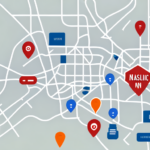Understanding UPS Shipping Rates from Barre, VT to Nashville, TN
If you're looking to ship a package from Barre, VT to Nashville, TN, it's important to understand how UPS shipping rates are calculated. There are numerous factors that can affect the cost of your shipment, from the weight and dimensions of your package to the speed of delivery you require. In this article, we'll provide an in-depth analysis of the factors that impact UPS shipping rates, how to get accurate quotes, and how to navigate the UPS website to find the best rates for your shipment.
The Factors That Affect UPS Shipping Rates: A Comprehensive Overview
The cost of shipping a package with UPS can vary based on several key factors. Understanding these factors can help you optimize your shipping strategy and potentially reduce costs. The most important factors that can influence your UPS shipping rates include:
- Weight and Dimensions: Heavier and larger packages typically incur higher shipping costs. UPS uses dimensional weight pricing for packages, which considers the package's size relative to its weight.
- Distance: The distance between the origin and destination affects the base rate. Longer distances generally result in higher shipping costs.
- Delivery Speed: Faster delivery options, such as Next Day Air or 2nd Day Air, cost more than standard ground shipping.
- Additional Services: Services like insurance, signature confirmation, and special handling for fragile or hazardous items can add to the overall shipping cost.
When calculating shipping rates, UPS takes all of these factors into consideration. Generally, you can expect to pay more for quicker delivery speeds, larger or heavier packages, and additional services like insurance or delivery confirmation.
Additionally, the type of item you are shipping can impact UPS shipping rates. Items such as hazardous materials or perishable goods require special handling and packaging, which may increase the overall shipping cost. According to the UPS Rate Guide, shipping costs can vary significantly based on item classification and handling requirements.
Seasonal demand also plays a crucial role in shipping rates. During peak holiday seasons, such as the months leading up to Christmas, shipping rates may increase due to higher demand and limited carrier capacity. For instance, a study by Business Insider noted that last-minute holiday shipping rates can spike by up to 30%.
How to Get Accurate Shipping Quotes for Your Barre, VT to Nashville, TN Delivery
Obtaining an accurate shipping quote for your package from Barre, VT to Nashville, TN is essential for budgeting and planning your shipment effectively. Here's how you can get precise estimates:
- UPS Online Shipping Calculator: The most straightforward method is to use the UPS website shipping calculator. By entering the weight, dimensions, origin, and destination zip codes, you can receive an immediate estimate of your shipping costs based on the current rates and available services.
- UPS My Choice: Signing up for UPS My Choice offers personalized shipping options and can help manage and predict shipping costs more accurately.
- Contacting a UPS Representative: For shipments with special requirements or higher volumes, working directly with a UPS representative can provide a more detailed and customized quote. They can assist in identifying the most cost-effective shipping options and optimizing your shipping strategy.
- Using Third-Party Shipping Platforms: Platforms like ShipStation or EasyPost can integrate with UPS and help you compare rates across different services to find the best fit for your needs.
Accurately measuring and weighing your package before requesting a quote will ensure that you receive the most precise shipping cost estimate. Additionally, consider any special services you may require, such as insurance or expedited delivery, as these will affect the final cost.
Navigating the UPS Website: Tips for Finding the Best Shipping Rates
The UPS website is a comprehensive tool for finding competitive shipping rates and managing your shipments effectively. To maximize your savings and optimize your shipping experience, consider the following tips when navigating the UPS website:
- Specify Your Delivery Date: Clearly indicate the desired delivery date to access rate options that align with your timeline. UPS often offers discounts for less urgent shipping schedules.
- Compare Delivery Speeds: Evaluate different delivery speeds such as Ground, 2nd Day Air, Next Day Air, and Express services to find the most cost-effective option that meets your delivery requirements.
- Utilize Discounts and Special Offers: Check for available discounts, promotional rates, or membership benefits that can reduce your shipping costs. Signing up for a UPS account may provide access to exclusive deals.
- Consider Alternative Locations: Sometimes shipping from or to alternative UPS locations or drop-off points can offer lower rates or more convenient pickup options.
- Use UPS Shipping Tools: Take advantage of tools like UPS My Choice, UPS Access Point locations, and the UPS Rate Calculator to streamline your shipping process and identify savings opportunities.
Additionally, always ensure that you accurately measure and weigh your package before searching for rates, as UPS offers different pricing tiers based on package size and weight. For larger or heavier shipments, consider using UPS Freight services, which are tailored for bulk and oversized shipments, providing more economical rates for such orders.
By leveraging these strategies, you can effectively navigate the UPS website to find the most advantageous shipping rates for your needs.
Surcharges and Fees: What You Need to Know About Additional Costs
While calculating your UPS shipping rates, it's crucial to account for potential surcharges and fees that can significantly impact the total cost of your shipment. Being aware of these additional charges helps in budgeting accurately and avoiding surprises. The most common UPS surcharges and fees include:
- Residential Delivery Fees: Delivering to a residential address may incur additional fees compared to commercial deliveries. This fee compensates for the extra time and complexity involved in residential deliveries.
- Fuel Surcharges: UPS applies fuel surcharges based on fluctuating fuel prices. These surcharges are typically calculated as a percentage of the base shipping rate and can vary with changes in fuel costs.
- Oversize Package Fees: Packages that exceed UPS's standard size and weight limits are subject to oversize fees. These fees are tiered based on the degree to which the package dimensions or weight surpass the thresholds.
- Additional Handling Fees: Shipments that are unusually heavy, awkwardly shaped, or require special handling may incur additional fees to cover the extra effort and resources required.
Moreover, when shipping internationally, be aware of customs duties and taxes that may apply. These fees depend on the value and nature of the goods being shipped, as well as the destination country's import regulations. To ensure compliance and avoid unexpected costs, it is advisable to consult the UPS International Shipping Guide and verify the applicable duties and taxes for your specific shipment.
Understanding and factoring in these surcharges and fees is essential for accurately estimating the total cost of your shipment and ensuring a smooth shipping experience.
Comparing UPS Shipping Rates with Other Carriers for Your Barre, VT to Nashville, TN Shipment
To ensure you're getting the most cost-effective and suitable shipping solution for your needs, it's beneficial to compare UPS shipping rates with other leading carriers. Some of the most popular shipping carriers include FedEx, USPS, and DHL. When evaluating these carriers, consider the following factors alongside the base cost:
- Delivery Speed: Different carriers offer varying delivery speeds. For instance, FedEx may provide faster overnight delivery options compared to USPS’s Priority Mail Express.
- Additional Fees and Surcharges: Each carrier has its own set of surcharges and fees. Comparing these can reveal hidden costs that may affect the overall pricing.
- Service Reliability: Assessing the on-time delivery rate and package handling quality is crucial. According to the [2023 Delivery Performance Report](https://www.ups.com/us/en/about/performance.page), UPS maintains a high on-time delivery rate, but it’s important to verify current performance metrics.
- International Shipping Capabilities: If your shipment has international components, compare the international shipping services and rates offered by each carrier.
- Customer Service: The quality of customer service can vary significantly between carriers. Reliable and responsive customer support is essential, especially for resolving issues quickly.
- Technology and Tracking: Compare the tracking capabilities and technological integrations offered by each carrier. Advanced tracking features can provide greater visibility and control over your shipments.
When comparing shipping rates, it’s important not only to look at the cost but also the overall value provided by each carrier. Consider factors such as speed, reliability, customer support, and additional services to make an informed decision. Additionally, reading customer reviews and analyzing carrier performance statistics can help you gauge each carrier's reliability and reputation in the industry.
For a detailed comparison of the top shipping carriers, visit ShipScience's comprehensive guide to understand the strengths and weaknesses of each option.
The Impact of Package Weight and Dimensions on Shipping Costs
The weight and dimensions of your package are critical factors that influence the overall shipping cost with UPS. UPS utilizes a pricing model known as dimensional weight (DIM weight) pricing, which considers both the size and the weight of your package to determine shipping rates. This means that for lightweight but large packages, the dimensional weight may exceed the actual weight, resulting in higher shipping costs.
- Actual Weight: This is the physical weight of your package as measured on a scale.
- Dimensional Weight: Calculated using the formula (Length x Width x Height) / Dimensional Factor (typically 139 for domestic shipments), dimensional weight accounts for the space your package occupies in the UPS transportation network.
To ensure you receive an accurate shipping quote and avoid unexpected fees or surcharges, it is essential to accurately measure and weigh your package. Utilizing the UPS Dimensional Weight Calculator can help you determine the dimensional weight of your package and understand how it may impact your shipping costs.
Moreover, the shipping method you choose plays a significant role in determining the cost. Expedited shipping options such as Next Day Air or 2nd Day Air typically incur higher costs compared to standard ground shipping. It’s important to assess the urgency of your shipment against your budget constraints to select the most cost-effective shipping method that meets your delivery timelines.
For larger or unusually shaped packages, consider consulting the UPS Packaging Guidelines to ensure compliance and optimize your packaging for cost efficiency.
Understanding Transit Times: How Delivery Speed Affects Shipping Rates
The delivery speed you select significantly influences the shipping rate of your UPS shipment. UPS offers a range of delivery options, each with varying transit times and associated costs. Generally, expedited delivery services like overnight or two-day shipping are more expensive than standard ground shipping options. Here’s a breakdown of how delivery speed affects your shipping rates:
- UPS Next Day Air: Guarantees delivery by the next business day. This is the fastest and typically the most expensive shipping option.
- UPS 2nd Day Air: Ensures delivery within two business days, offering a balance between speed and cost.
- UPS Ground: Provides cost-effective delivery with transit times based on distance, usually taking 1-5 business days.
- UPS Expedited: Offers delivery within three business days, suitable for shipments that are not time-sensitive but require more speed than standard ground shipping.
Choosing a slower delivery speed can lead to substantial cost savings, especially for non-urgent shipments. For example, UPS Ground shipping is often significantly less expensive than Next Day Air, making it an ideal option for budget-conscious shipments.
However, it’s essential to consider the destination and the reliability of the transit times offered by different carriers. UPS is renowned for its consistent and reliable delivery schedules, but transit times can still vary based on factors such as destination location, weather conditions, and logistical challenges.
To determine the most suitable delivery speed, assess the urgency of your shipment and weigh it against your budget constraints. Utilize the UPS Transit Time Calculator to estimate the transit time and cost for each shipping option, ensuring that you select the service that best aligns with your needs.
Negotiating Better Rates with UPS for Your Regular Shipments
For businesses and individuals who regularly ship packages with UPS, negotiating better rates can lead to significant cost savings. UPS offers tailored solutions and discounts for high-volume shippers and long-term clients. Here’s how you can negotiate more favorable rates with UPS:
- Establish a Relationship with a UPS Representative: Initiate contact with your local UPS representative or account manager. Building a strong relationship can facilitate discussions about customized rate agreements and service options.
- Analyze Your Shipping Volume and Patterns: Provide UPS with detailed information about your shipping volume, frequency, package dimensions, and destinations. Highlighting consistent or increasing shipping volumes can strengthen your bargaining position.
- Benchmark Against Competitors: Research and collect rates from other shipping carriers like FedEx and USPS. Presenting competitive offers during negotiations can motivate UPS to provide more competitive pricing.
- Commit to Long-Term Contracts: Offering to commit to a longer-term shipping agreement in exchange for discounted rates can be an effective negotiation strategy.
- Consider Bundling Services: Combining multiple services, such as international shipping alongside domestic shipments, can provide leverage for negotiating comprehensive discounts.
Additionally, consider enrolling in UPS's business solutions programs, which offer various benefits including discounted rates, enhanced billing options, and dedicated support. By demonstrating your loyalty and shipping commitment to UPS, you can negotiate more advantageous rates that meet your business needs.
Remember, negotiating better rates requires preparation and a clear understanding of your shipping requirements and budget. Effective negotiation can lead to substantial savings, making UPS a more cost-effective carrier for your regular shipments.
How to Properly Pack and Label Your Shipment to Avoid Extra Fees and Delays
Proper packing and labeling are vital steps to ensure that your UPS shipment arrives safely, on time, and without incurring additional fees or delays. Adhering to best practices in packaging and labeling not only safeguards your items but also streamlines the shipping process. Here’s how to effectively pack and label your shipment:
- Use Durable Packaging Materials: Select sturdy boxes or envelopes that can withstand the rigors of transit. Heavy-duty corrugated boxes are recommended for fragile or valuable items. Avoid using old or damaged boxes that may compromise the integrity of your shipment.
- Protect Your Items: Utilize appropriate cushioning materials such as bubble wrap, packing peanuts, or foam inserts to conceal and protect your items from movement and impact within the package.
- Seal Packages Securely: Use high-quality packing tape to seal all seams and edges of your package firmly. Reinforce the bottom of the box with extra tape to prevent accidental openings during handling.
- Accurate Labeling: Ensure that your shipping label is clear, legible, and securely affixed to the package. Include both the sender’s and recipient’s full addresses, contact numbers, and any special instructions. Avoid covering the barcode or critical information with tape or markings.
- Comply with UPS Labeling Standards: Familiarize yourself with the UPS Packaging and Labeling Guidelines to ensure compliance and prevent shipment rejections or delays.
Additionally, accurately weighing and measuring your package before shipping is crucial. Exceeding the weight and size limits set by UPS can lead to unexpected fees and may require you to repack or pay for oversized package rates. Use a reliable scale and a measuring tape to verify that your packages meet UPS specifications before initiating shipment.
Choosing the appropriate shipping method also impacts the cost and delivery time of your package. Evaluate options based on your budget, the urgency of delivery, and the nature of the contents. For instance, expedited shipping may be necessary for time-sensitive or perishable items, while standard ground shipping can be a cost-effective choice for non-urgent deliveries.
By following these packing and labeling best practices, you can minimize the risk of damage, avoid unnecessary fees, and ensure a smooth and efficient shipping experience with UPS.
Common Mistakes to Avoid When Calculating UPS Shipping Rates from Barre, VT to Nashville, TN
When calculating your UPS shipping rates for a package from Barre, VT to Nashville, TN, it's essential to avoid common mistakes that can lead to inaccurate quotes, unexpected costs, or shipment delays. Here are some frequent errors to watch out for:
- Incorrectly Measuring Package Dimensions or Weight: Inaccurate measurements can result in an incorrect shipping quote. Always use a reliable scale for weighing and a proper measuring tape for dimensions. Remember to include the package's thickness when measuring.
- Failing to Account for Additional Services or Requirements: Services such as insurance, signature confirmation, or special handling are not always included in the base rate. Ensure you consider these additional services when calculating total shipping costs.
- Choosing the Wrong Delivery Speed: Selecting a delivery speed that doesn't align with your needs can either lead to excessive costs or delayed shipments. Assess the urgency of your delivery to choose the most appropriate shipping option.
- Overlooking Potential Fees and Surcharges: As discussed earlier, surcharges for residential deliveries, fuel, oversize packages, and other fees can significantly increase your total shipping cost. Always review the complete fee structure before finalizing your shipment.
- Improper Packaging: Incorrect or inadequate packaging can lead to damaged items and additional fees. Follow UPS packaging guidelines meticulously to ensure your shipment is secure and compliant.
- Not Considering Dimensional Weight: For large but lightweight packages, dimensional weight pricing may apply. Providing dimensions without considering this factor can lead to higher-than-expected shipping costs.
- Ignoring UPS Guidelines and Policies: Each carrier has specific rules regarding prohibited items, packaging standards, and labeling requirements. Familiarize yourself with these guidelines to prevent shipment rejections or delays.
By being diligent and meticulous in your shipping preparations, you can avoid these common mistakes and ensure that your UPS shipping rates are accurate and reflective of your actual shipment needs.
Additionally, always double-check your shipping details and utilize UPS’s resources, such as the UPS Packing Guidelines, to ensure your package is properly prepared for transit.
Special Considerations for Shipping Fragile or Perishable Items with UPS
Shipping fragile or perishable items with UPS requires meticulous preparation to ensure the safety and integrity of your goods throughout the transit process. Here are key considerations to keep in mind:
- Enhanced Protective Packaging: Use high-quality, sturdy packaging materials specifically designed for fragile or perishable items. For fragile items, utilize cushioning materials such as bubble wrap, foam inserts, or custom-shaped void fill to prevent movement and absorption of shocks during handling.
- Temperature-Controlled Shipping: Perishable items like food, flowers, or pharmaceuticals may require temperature-controlled shipping solutions. UPS offers services such as UPS Temperature-Controlled Shipping, which ensures your items are kept within specific temperature ranges during transit.
- Expedited Shipping Options: To minimize the risk of spoilage or damage, opt for expedited shipping methods such as UPS Next Day Air or UPS 2nd Day Air. Faster delivery reduces the time your perishable items spend in transit.
- Proper Labeling: Clearly label your package as "Fragile" or "Perishable" to alert UPS handlers to exercise extra care. Additionally, include any necessary handling instructions, such as "Keep Upright" or "Do Not Freeze," to ensure proper treatment during shipment.
- Use of Insulation and Refrigerants: For perishable items, consider using insulated packaging materials and refrigerants like gel packs or dry ice to maintain the required temperature inside the package. Ensure compliance with UPS regulations regarding the use of refrigerants, especially dry ice.
- Insurance and Tracking: Invest in additional insurance coverage for high-value or sensitive items to protect against potential loss or damage. Utilize UPS's comprehensive tracking services to monitor your shipment in real-time and receive notifications about its status.
Following these best practices will help ensure that your fragile or perishable items are handled with the utmost care and arrive in optimal condition. For detailed guidelines on packaging and shipping sensitive items, refer to the UPS Packaging and Shipping Resources.
Tracking Your Shipment: What You Need to Know About the UPS Tracking System
Staying informed about the status of your UPS shipment is crucial for managing your deliveries effectively and ensuring timely arrival of your packages. UPS offers a robust tracking system that provides real-time updates and comprehensive visibility throughout the entire delivery process. Here’s what you need to know about the UPS tracking system:
- Real-Time Tracking: Once your package is shipped, you receive a unique tracking number that allows you to monitor its progress in real-time. The UPS tracking tool offers detailed information on the package’s current location, transit status, and estimated delivery time.
- Notifications and Alerts: Opt-in for notifications to receive automatic updates via email or SMS. This feature keeps you informed about key milestones, such as when your package is out for delivery or if any delays occur.
- Access Through Multiple Platforms: You can track your shipment through the UPS Tracking Page, the UPS mobile app, or by integrating the UPS tracking API with your own systems for seamless updates.
- Delivery Confirmations: The tracking system provides delivery confirmations, including the date and time of delivery, as well as the recipient's signature (if applicable). This adds an extra layer of security and accountability to your shipments.
- Exception Management: In the event of an unexpected delay or issue, the tracking system flags exceptions and provides detailed information on the cause and expected resolution time.
- International Tracking: For international shipments, the UPS tracking system complies with global standards, allowing you to monitor your package across different countries and customs checkpoints.
- Integration with UPS My Choice: Enrolling in UPS My Choice offers enhanced tracking features, including the ability to reroute packages, provide delivery instructions, and set delivery preferences tailored to your convenience.
Utilizing the UPS tracking system ensures that you are consistently aware of your shipment’s status, enabling you to plan accordingly and address any potential issues promptly. Effective tracking not only provides peace of mind but also enhances your overall shipping experience by ensuring transparency and reliability.
By understanding how UPS shipping rates are calculated and leveraging the UPS tracking system, you can achieve a more cost-effective and efficient shipping process.






















